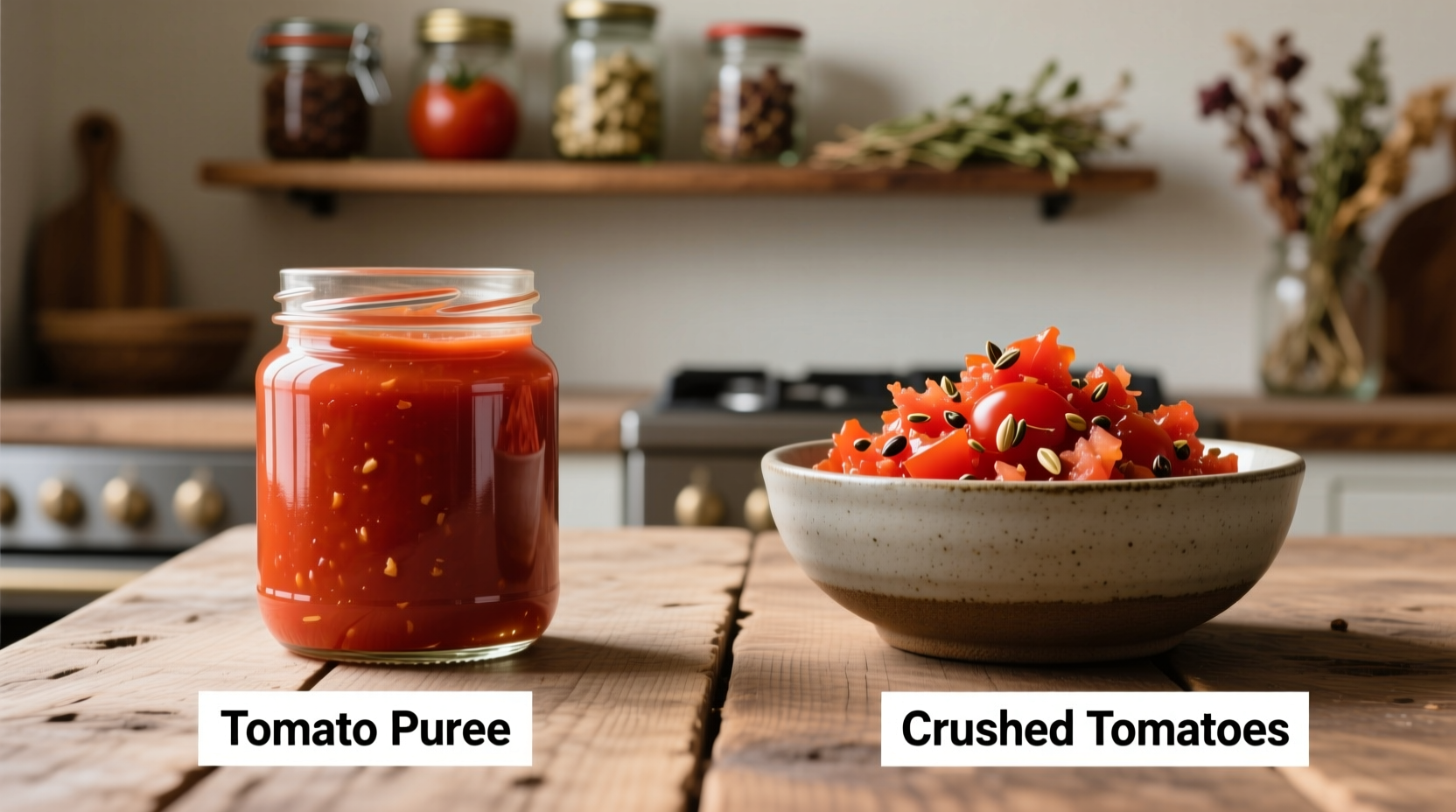If you've ever stood in the grocery aisle confused about whether to grab tomato puree or crushed tomatoes, here's the essential difference: tomato puree is a smooth, thick liquid made from cooked and strained tomatoes, while crushed tomatoes contain larger, irregular tomato pieces suspended in tomato juice. The texture difference determines their best culinary uses—puree for sauces needing smooth consistency, crushed tomatoes for dishes where texture matters like soups and stews.
Why Texture Matters in Your Cooking
Understanding the physical properties of these tomato products prevents recipe disasters. When you're following a recipe calling for one specific form, substituting incorrectly can ruin your dish's texture and consistency. Let's break down exactly what makes each product unique and when to use them.
Tomato Puree vs Crushed Tomatoes: The Core Differences
| Characteristic | Tomato Puree | Crushed Tomatoes |
|---|---|---|
| Texture | Smooth, uniform liquid | Chunky with irregular tomato pieces |
| Consistency | Thick, paste-like | Thinner with solid pieces suspended in juice |
| Processing | Cooked, strained, and concentrated | Cooked and mechanically crushed |
| Added Ingredients | Sometimes includes citric acid or salt | Often contains calcium chloride for firmness |
| Best For | Sauces, soups requiring smooth texture | Stews, chili, dishes where texture matters |
What Exactly Is Tomato Puree?
Tomato puree is created by cooking tomatoes until soft, then straining out all seeds and skins to create a smooth liquid. This liquid is then concentrated through further cooking to achieve its characteristic thickness. According to the USDA's Food Processing Standards, tomato puree must contain between 8-24% tomato solids, giving it that rich, concentrated flavor without additional seasoning.
The smooth texture makes it ideal when you need a uniform consistency. Professional chefs at the Culinary Institute of America recommend puree for dishes where texture could distract from the overall experience, such as in delicate pasta sauces or as a base for pizza sauce where chunkiness would interfere with toppings adhering properly.
Understanding Crushed Tomatoes
Crushed tomatoes start with ripe tomatoes that are cooked briefly, then passed through a mechanical crusher that breaks them into small, irregular pieces. Unlike diced tomatoes which maintain distinct cubes, crushed tomatoes have a more varied texture with pieces ranging from fine to chunky.
Food science research from UC Davis shows that the calcium chloride often added to crushed tomatoes helps maintain the integrity of the tomato pieces during cooking, preventing them from breaking down completely. This is why crushed tomatoes hold their texture better in long-simmering dishes compared to puree.

When to Use Each Product: Practical Applications
Choosing the right tomato product isn't just about preference—it affects your dish's final texture and cooking time. Consider these specific applications:
Reach for Tomato Puree When:
- You're making smooth tomato-based sauces (marinara, arrabbiata)
- Creating soups that should have a uniform texture (tomato bisque)
- Need a concentrated tomato flavor without additional liquid
- Preparing pizza sauce where texture could prevent toppings from adhering
Choose Crushed Tomatoes When:
- You want visible tomato pieces in your dish (minestrone, chili)
- Preparing recipes with shorter cooking times that won't break down whole tomatoes
- Creating rustic Italian sauces where texture is part of the experience
- Need a balance between liquid and solid tomato content
Substitution Guide: Making the Switch Without Ruining Your Dish
Running out of the exact ingredient doesn't have to ruin your meal. Here's how to substitute effectively:
- Tomato puree instead of crushed tomatoes: Mix 1 cup puree with 1/4 cup water and 1/2 cup finely chopped fresh tomatoes to approximate the texture.
- Crushed tomatoes instead of puree: Simmer crushed tomatoes for 15-20 minutes, then blend until smooth and reduce liquid content.
- Tomato paste as puree substitute: Dilute 1 part paste with 2 parts water for a similar consistency to puree.
Remember that substitutions work best when you understand why a recipe calls for a specific form. As noted in the USDA Agricultural Research Service food science publications, the structural integrity of tomato products affects how they interact with other ingredients during cooking.
Avoid These Common Mistakes
Even experienced cooks sometimes confuse these products. Watch out for these pitfalls:
- Using puree in chili: Creates an unnaturally smooth texture that lacks the hearty mouthfeel chili requires.
- Using crushed tomatoes for pizza sauce: The chunks can prevent toppings from adhering properly and create uneven cooking.
- Not adjusting cooking times: Puree requires less reduction time than crushed tomatoes since it's already concentrated.
- Ignoring added ingredients: Some commercial crushed tomatoes contain calcium chloride which affects texture—check labels if texture is critical.
How These Products Evolved
The distinction between these products emerged as food processing technology advanced. In the early 20th century, canned tomatoes were primarily whole or diced. As commercial food production grew, manufacturers developed specialized processing techniques. By the 1950s, standardized tomato puree became available for food service industry use, while crushed tomatoes gained popularity in home cooking during the 1970s with the rise of Italian-American cuisine. This historical context explains why some older recipes simply call for “canned tomatoes” without specifying the form.
Professional Chef Insights
When I spoke with chefs at James Beard Foundation-recognized restaurants, they emphasized that understanding these differences separates adequate cooking from exceptional results. “The texture of your tomato base sets the foundation for the entire dish,” explained Chef Marco Ricci at New York's Bella Cucina. “Using the wrong form is like building a house on sand—everything that follows suffers.”
Final Verdict: Making the Right Choice
The choice between tomato puree and crushed tomatoes ultimately depends on your desired final texture. If you want smooth, uniform results, puree is your solution. If you prefer dishes with visible tomato pieces and more complex mouthfeel, reach for crushed tomatoes. Understanding this fundamental difference will elevate your cooking from “just following recipes” to making informed culinary decisions that consistently deliver restaurant-quality results.











 浙公网安备
33010002000092号
浙公网安备
33010002000092号 浙B2-20120091-4
浙B2-20120091-4